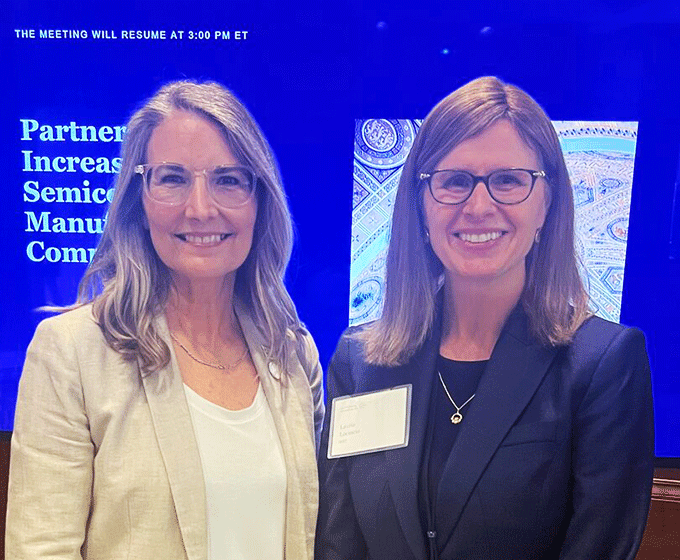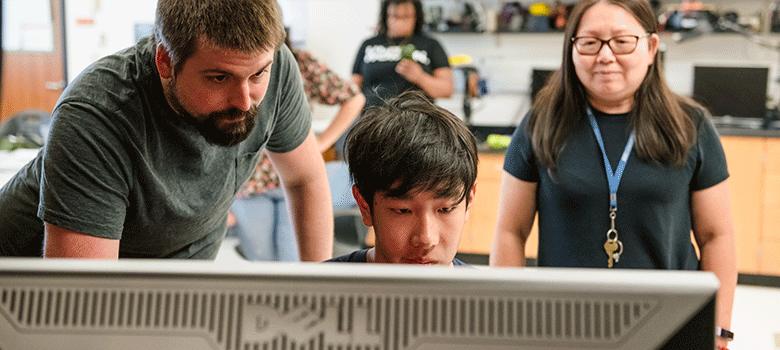
- Federal Partnership
- Innovation
Select UTSA senior leaders recently attended the Government University Industry Research Roundtable (GUIRR) at the National Academies in Washington, D.C. UTSA was invited to participate in a joint panel addressing global cybersecurity for research infrastructure alongside senior leadership from the National Institute of Standards and Technology (NIST) and Dell Technologies.
GUIRR convened the day-long workshop for its members, experts and invited guests to provide a forum on policy priorities across the research enterprise, including public-private-academic partnerships, science and technology innovation, national security and national prosperity.
“I’m getting questions from peers across the country on how we did what we did and on the steps we took. Sharing our story with others is so important.”

Attendees included leadership from Lawrence Livermore National Laboratory, University of Maryland, The Ohio State University, University of Illinois at Urbana Champaign, MIT Lincoln Laboratory, Johns Hopkins Applied Physics Laboratory, National Science Foundation, U.S. Environmental Protection Agency, IBM Research at the Almaden Lab, Office of the Director for National Intelligence, Space Operations at NASA, Atom Research Alliance and Intel Labs.
Alignment to deliver world class research ecosystems
Kendra Ketchum, UTSA CIO and vice president for information management and technology, spoke about the importance of partnerships to drive digital transformation alongside NIST Director and Undersecretary of Commerce Laurie Locascio and Dell Leader Deborah Stokes. Moderated by Al Grasso, immediate past president and CEO of the MITRE Corporation, the panel explored the world-class model UTSA has created in collaboration with Dell and NIST for a high-performing computing research ecosystem and resilient infrastructure.
Over the last two years, UTSA has partnered with Dell to expand its research infrastructure—including hardware, software and virtual environments—and invest in high-performance computing (HPC), enhancing operations and security.
“This group came together to come up with strategic ideation around delivering world class technology for our research enterprise,” Ketchum explained. “My goal was to reduce the time to science by expanding and elevating the research infrastructure and adding more high-performance computing resources. This resulted in researchers who don’t have to worry about standing up their own ecosystems and can focus on obtaining the results of their investigations.”
Investing in the research infrastructure to reduce the time to science
“Investing in our hyperconverged infrastructure allowed us to really lean into Dell's expertise,” Ketchum explained. “Leveraging Dell’s engineering and HPC skills enabled us to conduct infrastructure upgrades and replacements to fill a gap for our research community. We know that if we want to get our researchers to their outcomes faster—reducing the time to science—we must be as committed as they are to strategic thinking and innovation.”
Importance of standardization in cyber for IP protection
The government partnership came into play as UTSA followed the NIST guidelines on cybersecurity, which was a critical piece. As a former vice president for research in academia, Locascio understands the intricacies and nuances of a research environment. Her office is responsible for setting cyber standards for the country.
The security of intellectual property and research investigations is a growing international concern that universities must be prepared to address. Universities and other institutions are subject to hacking attempts by mature nation-state actors and criminals trying to steal identities and research IP to create chaos across the globe. By building a system according to NIST standards, UTSA has created a resilient environment capable of withstanding the more than one million infiltration attempts that take place each day.
UTSA’s new hyperconverged infrastructure, combined with the State of Texas’ cybersecurity framework, gives the institution a very mature platform and portfolio for cybersecurity research. Students get the benefit of having this advanced ecosystem to go out and really research everything in the cyberspace, including data security, incident management and response—all elements of a fully functioning ecosystem.
Based on her collaborative work with industry and government, Ketchum was invited to speak on research IT and security practices. UTSA is a model in this field with IT systems that not only protect researchers and their IP but also the institution and its business continuity—ensuring that the university stays online and operates effectively around the clock.
Partnerships that deliver innovative solutions and secure ecosystems beyond campus
Beyond GUIRR, Ketchum has also been sharing this success story with her peers on the Leadership Board for CIOs (LBCIO) across the U.S. over the last few months. The interest is high.
“I’m getting questions from peers across the country on how we did what we did and on the steps we took. Sharing our story with others is so important,” Ketchum said. “We did reduce the time to science. Researchers are getting their outcomes sooner than anticipated. We built a full disaster recovery and business continuity data center by breaking down the silos and focusing on the desired outcomes of all our stakeholders.”
Jaclyn Shaw, interim vice president for research, economic development, and knowledge enterprise, who now serves as the university’s representative to GUIRR, was also in attendance.
“It was just a stellar opportunity to showcase the work Kendra and the University Technology Solutions team are doing on behalf of UTSA. What we have done under Kendra’s leadership is very much a best practice and a model amongst higher educational institutions in the U.S.,” Shaw said. “It takes industry, it takes government and it takes universities to really build a borderless ecosystem. To have our CIO sit alongside the nation's director for cyber standards was truly an honor for our institution.”
Membership in GUIRR was driven by UTSA President Taylor Eighmy’s vision to be part of a larger innovation ecosystem with peers to address the growing complexity of research opportunities. He also serves as the institutional leadership representative on its Council of the National Academies' Government-University-Industry Research Roundtable. Since joining in 2021, membership in GUIRR is a clear outcome of UTSA’s recent R1 designation.
“UTSA’s participation as a model for addressing global cyber security for research infrastructure alongside national leaders like Dell and NIST is a significant honor and affirms our university’s rapid trajectory towards becoming the next great public research university,” Eighmy said. “GUIRR is a critical forum for advancing collaboration across research ecosystems as it brings together thought leaders from all sectors to discuss innovative solutions to society’s grand challenges, and we’re proud to collaborate alongside those leaders to advance the nation’s science and technology agenda.”